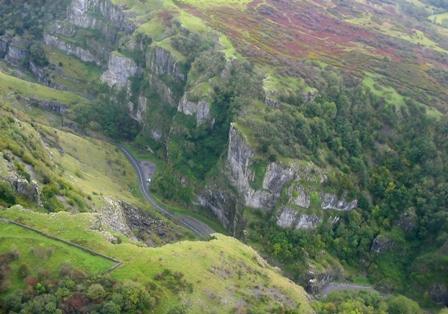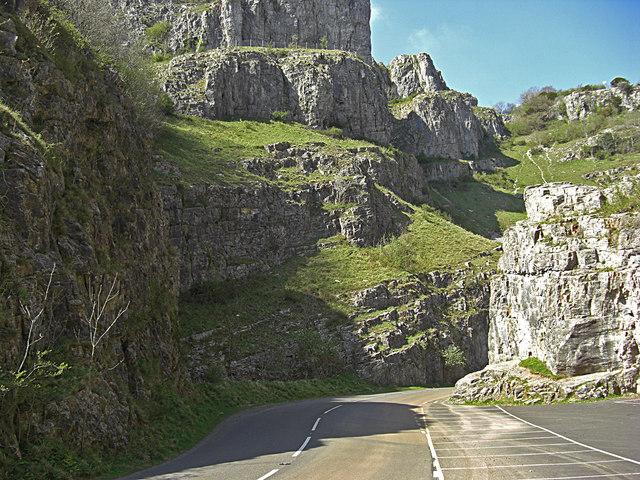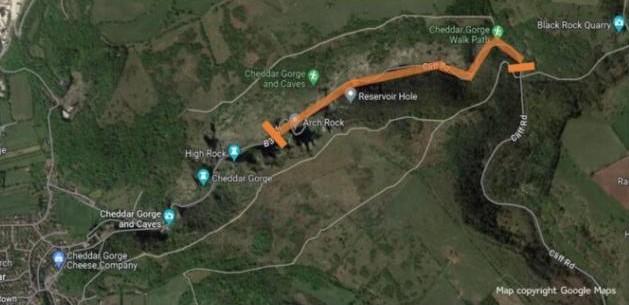- News
- Reviews
- Bikes
- Accessories
- Accessories - misc
- Computer mounts
- Bags
- Bar ends
- Bike bags & cases
- Bottle cages
- Bottles
- Cameras
- Car racks
- Child seats
- Computers
- Glasses
- GPS units
- Helmets
- Lights - front
- Lights - rear
- Lights - sets
- Locks
- Mirrors
- Mudguards
- Racks
- Pumps & CO2 inflators
- Puncture kits
- Reflectives
- Smart watches
- Stands and racks
- Trailers
- Clothing
- Components
- Bar tape & grips
- Bottom brackets
- Brake & gear cables
- Brake & STI levers
- Brake pads & spares
- Brakes
- Cassettes & freewheels
- Chains
- Chainsets & chainrings
- Derailleurs - front
- Derailleurs - rear
- Forks
- Gear levers & shifters
- Groupsets
- Handlebars & extensions
- Headsets
- Hubs
- Inner tubes
- Pedals
- Quick releases & skewers
- Saddles
- Seatposts
- Stems
- Wheels
- Tyres
- Health, fitness and nutrition
- Tools and workshop
- Miscellaneous
- Tubeless valves
- Buyers Guides
- Features
- Forum
- Recommends
- Podcast
 Cyclists riding up Cheddar Gorge (Bikmo)
Cyclists riding up Cheddar Gorge (Bikmo)Cyclists could enjoy traffic-free days on Cheddar Gorge as 80% back proposal... but opposition claim "people will be run over by bikes" and "Putin's election was fairer"
Traffic-free days at Cheddar Gorge have taken a step closer to becoming a reality after a consultation saw more than 80 per cent of respondents express support for the idea that closing the road to motor traffic would make the site more accessible for pedestrians, cyclists and other non-vehicular visitors.
The Mendip Hills National Landscape Team said the support for one traffic-free day a month — 71 per cent saying they wanted to see it on a Sunday, while just 17 per cent were not in favour of the road closure — is exciting and the project will be advanced to the next phase, which will see discussions with partners and the Highway Authority to "decide on the best options", although the team did mention the potential for an Experimental Traffic Regulation Order (ETRO) to be used to implement the closure.
Jim Hardcastle from the Mendip Hills National Landscape Team said he was "thrilled to have had so much positive feedback" and stressed that "valuable and interesting points which we will carefully consider" include "the speed at which cyclists may come down the Gorge, the impact on local businesses, the provision of parking and space for vehicles to turn around, and concerns about the length of the diversion route and impact on other roads nearby".
However, he said, "We are confident that we can take these concerns into account when deciding on the next steps in the process."
Despite less than a fifth of the 1,700 respondents expressing opposition to the road closure, the news of the project moving on to the next stage prompted wild criticism and complaints on Facebook, a vocal opposition to the road closure flooding the Mendip Hills National Landscape Team with negative comments.
Some questioned what percentage of respondents were local residents, while another accused the consultation of being "nonsense" and less fair than "Putin's election".
"When you hear the demographic who were polled, they were always going to get the answer they wanted. My only surprise is that it wasn't 90 per cent instead of 80,"
Ché Moore commented.
Another, from Chris Maunders, said: "Leaving it open to pushbikes is a ridiculous idea. To be honest they are more dangerous than the cars because you cannot hear them and they come down that Gorge [at] over 30 miles an hour. People will be run over by bikes all over the place."
However, Steve Wilson also commented: "How can something as innocuous as this get so many people so angry? I wonder if all those shouting about it now, took the same minimal time to actually respond to the consultation?" Likewise, Vanessa Winchester pointed out the vocal opposition was to a plan to close the road for "only one day a month".
The project has been funded by the Department for Environment, Food and Rural Affairs (DEFRA) to explore the possibility of opening up the beauty of the country's highest inland cliff and the twisting road that runs through the Gorge to more people by closing the road to traffic once a month, enabling horse riders, cyclists, pedestrians and those with limited mobility who might otherwise be unable to enjoy the normally busy road.
During the six-week consultation process, feedback was sought, "especially from local residents", the majority expressing support for the closure.
On top of the headline figure that more than 80 per cent agreed it would make the route more accessible for pedestrians, cyclists and other non-vehicular visitors, and 71 per cent would like to see the road closed on a Sunday, around half of respondents (48 per cent) said they would enjoy the traffic-free environment.
When it came to walking groups, 47 per cent who responded said they would use the route on traffic-free days, while 46 per cent of cycling groups and 45 per cent of families also expressed interest in the idea of utilising the road closure to enjoy the Gorge. A third of respondents said they would like to see live music events, and a quarter said they would like to see theatre performances as part of wider events put on around the road closures.
"We are thrilled to have had so much positive feedback to this proposal and we are grateful to everyone who took the time to respond. We have received many comments expressing support from those who would be more likely to visit the Gorge on traffic-free days to enjoy the beauty and tranquillity of the area," Jim Hardcastle, the manager of the Mendip Hills National Landscape Team said.
"There were some respondents who raised valuable and interesting points which we will carefully consider. These include the speed at which cyclists may come down the Gorge, the impact on local businesses, the provision of parking and space for vehicles to turn around, and concerns about the length of the diversion route and impact on other roads nearby. We are confident that we can take these concerns into account when deciding on the next steps in the process.
"We are excited to take this project into the next phase, and look forward to improving this picturesque location by opening it up to a wider range of visitors. Over the next few months we will be working with partners and the Highway Authority to decide on the best options. Look out for updates from us later in the year.
"There has also been some feedback that covers issues outside the scope of the temporary road closure. These include road improvements, support for local businesses and improved public transport. While these are out of our direct control, we appreciate this feedback being raised with us and will share it with partners who are well placed to respond."
Dan is the road.cc news editor and joined in 2020 having previously written about nearly every other sport under the sun for the Express, and the weird and wonderful world of non-league football for The Non-League Paper. Dan has been at road.cc for four years and mainly writes news and tech articles as well as the occasional feature. He has hopefully kept you entertained on the live blog too.
Never fast enough to take things on the bike too seriously, when he's not working you'll find him exploring the south of England by two wheels at a leisurely weekend pace, or enjoying his favourite Scottish roads when visiting family. Sometimes he'll even load up the bags and ride up the whole way, he's a bit strange like that.
Latest Comments
- Bill H 3 min 9 sec ago
It's not just sportsmen and women who get ripped off by their accounts and advisors. Kevin Bacon lost his money to Bernie Madoff's Ponzi scheme,...
- quiff 10 min 56 sec ago
I still use a Garmin 800 (of the plug it in and hope the Windows app works generation) and that is a bit of a pain. My c. 3 year old entry level...
- mattw 14 min 48 sec ago
Sorry, but WTF on some of that?...
- chrisonabike 35 min ago
Good point, I'd probably conveniently forgotten that due to my part in that (voting, "I paid a lot of tax and bought a fraction of a bomb" etc.)
- the little onion 2 hours 55 min ago
Rather artistic photo of this (driverless) car that has ended up on its roof on a dead straight road in Bradford....
- slc 4 hours 36 min ago
No doubt it will catch on in Plymouth, but it is Devon, where everything happens 10 years later. Not least the buses....
- mctrials23 5 hours 17 min ago
GCN just did a cool video on this. All I could think by the end was that perhaps if you got to do what the presenter did and mince around Italy in...
- ravenbait 5 hours 25 min ago
I missed that, thanks for pointing it out. I can't comment, as that's outside my area of expertise. Apologies to Rendel. This is why they should be...



Add new comment
41 comments
Some thought should be given to how going downhill is acheiveable - children, dogs will go anywhere and anytime. Oh and squirrels.
Snakes ate all the squirrels.
As mentioned by others many times - the majority of cyclists using the road on the proposed closure dates will be much slower. Most "enthused" riders will be trying to go up as quick as possible - much slower than trying to get down as fast as possible.
Pedestrians are struck down daily by people in motor vehicles at a rate and risk factor much greater than that of being struck by a cyclist. Yes, there will be a small increased risk due to the topography, and the lack of comparible extreme danger, but it's not going to outstrip the existing dangers which are proposed to be removed entirely by closing the road to motor traffic.
If anyone becomes a danger to themselves or others on an open road, they *should* expect to face appropriate punishment. It should be expected that should be no different on a shared space closed to motor traffic.
*I say Should as there are thousands of road traffic offences committed daily that go unpunished due to the fact no evidence exists of their transgressions.
It was steep enough slope last time I visited.
You cant even get people to walk on NSL country lanes,with traffic, with any semblance of sense
Take away the vehicles and its likely to become everyone's worst shared cycle path except with people stopping to take photos of the scenery.
That's before you get mixed ability groups of riders involved, wasnt there a crash years back a rider was seriously hurt or killed avoiding a slower group , may even been a car that just stopped, there ?
It's nice idea, but practical safety wise it needs alot more work
If asking residents and those with families slopes it, more than 55% of the responces slopes it towards the 45% responses from visitors they might have a point, NOT! Maybe the residents of Somerset (36%) are the demographic they don't like
Am I missing something?
The road will be closed to motor traffic to make it more friendly for cyclists and pedestrians.
So the road will probably be full of pedestrian tourists during that open (closed?) day - I honestly can't see a local roadie club using the road during that time for that very reason. And the 'recreational' cyclists on there will be riding along at far less than 30mph.
On the other hand, Chris Saunders, you could also choose to look before walking rather than relying on whether you can hear something coming You know - like (I hope) you do when crossing any other road.
You know - like (I hope) you do when crossing any other road.
Hearing is the primary sense these days when sight is used for staring at screens.
Most people in London have headphones on too , so I never trust hearing or sight
I wonder how many recreational cyclists will even go down, given they then have to climb back up which may put a lot of them off.
I've never been down my self just 2 or 3 times up it
Never been but love the ideal of this. Well done to all the campaigners
Pages